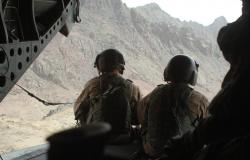Uncomfortable Thoughts on the Fall of Afghanistan

Scott Montgomery unpicks the discourses surrounding the U.S.' uncomfortable withdrawal from Afghanistan.
There is an ugly quality of thrill in the surge of media coverage on Afghanistan. Flush with victory, the Taliban are said to have “run the U.S. out of town,” its “forever war” ending in “in ruins” and “revelations of hubris.” The far right agrees entirely: the “Afghanistan catastrophe is an American humiliation.” For once, through the lens of headlines, Americans seem reunited.
Of course, that is an illusion. Most of the right has used the “opportunity” to blame President Biden for everything, including the suicide bombings by the ISIS-K group. In the past, such events evoked unified condemnation of the perpetrators. But in the era of “stolen” elections, this is no longer the case. “Joe Biden has blood on his hands,” tweeted Rep. Elise Stefanik, a top House Republican, “This horrific…disaster is solely the result of [his] weak and incompetent leadership.” Biden must “resign in disgrace” (Donald Trump’s words) or be impeached. The fact that Trump forged the actual agreement to withdraw U.S. forces does not seem relevant. Neither does the truth that the far right in the U.S. and Europe express admiration for the Taliban, even a degree of Kameradschaft, for their “defeat of liberalism.”
Meantime, there is now an established calculus for how to weigh the events of war, and this has been almost universally applied to Afghanistan. It involves citing lives and dollars. The 20-year conflict, we are told, cost the U.S. 2,448 troops and a trillion dollars (some say more). This is the “blood and treasure” system of measurement. It is hard to know which figure should pull more on our response. Does the second number honor the first, or trivialize it? Taken together, they tell us each American life cost $409 million. Those were indeed valuable lives. What of Afghan lives? At least 66,000 national military and police died, as well as more than 47,250 civilians, by one estimate. These, then, are worth many times less.
The Wrong Spectacle
In its breathless excitement, the press has offered a voyeuristic spectacle of collapse in a distant nation. The evacuation of people, U.S. citizens and Afghans who did service on the side of America’s troops and organizations, has been called chaotic, frantic, and desperate, and repeated imagery of crowds, barbed wire, anxious faces, frightened children, seems to bear this out. The ISIS terror attack, with its horrendous death toll, has been seen as “transforming a scene of desperation into one of horror,” thus posing the violence not as a terrible disruption but an extension of the ongoing process of evacuating people.
Yet during the first ten days of this process, 100,000 people were safely flown out of the country. No other airlift has ever achieved anything like it, the organized transport of an entire city to distant safety. Not a single U.S. citizen and only a handful of Afghans were seriously injured or killed, despite the presumed reign of bedlam and mayhem. If the larger situation—sudden and unforeseen collapse without violence—has aspects of real chaos, the U.S. military has maintained a high level of control at the center of a fearful flow out of the country.
While this was going on, however, much more serious damage was happening at home, in the U.S. A far greater number of Americans were being rushed into hospitals and intensive care units, more than a thousand dying every day from an “enemy” most failed to believe was dangerous or even real. During the 20 years that U.S. soldiers have been in Afghanistan, hoping to keep the homeland protected, American society has itself deteriorated into a state of cultural civil war and endangerment.
One might dwell for a moment on statements by Lt. General H.R. McMaster. Prior to becoming National Security Advisor to the Trump Administration, McMaster served as Deputy Commander of Coalition forces in Afghanistan and had a distinguished career fighting in Iraq and the Gulf War and as a research fellow at the Hoover Institute at Stanford University. “We should remember,” he proclaimed in a tv interview, “that tens of thousands of [Afghans] gave their lives to protect the freedoms that they have enjoyed since 2001, but also to protect us, really, from modern-day barbarians. I mean, Afghanistan is in many ways on a modern-day frontier between barbarism and civilization.”
It is, first of all, a disturbing confession. After 20 years, this nation of 40 million is about to be catapulted back into a primitive, rude existence, which is the essence both of Islamic fundamentalism and Afghanistan itself. Thus, by implication, the U.S. was never going to succeed; it lacked the philosopher’s stone to transform a pre-modern “frontier” into a “civilized” nation-state. This seems a crudely satisfying view of a long-term, victorious enemy but a brutal and condescending one of the country.
No less, it is an affront to history. From 1933 to 1973, Afghanistan was stable and largely peaceful, having commercial, diplomatic, and cultural relations established with Europe and the U.S. Western tourists regularly visited, a free press existed, and the education of girls, with hijab and often without, was widespread (many pictures here from the 1960s). Lt. General McMaster might think of the 1960s as ancient history, but there are living Afghans who look upon this period with great fondness. McMaster, who has a doctorate in American History, probably knows better than to use such archaic and imperialistic terms as “barbarism.” Perhaps, in a moment of nervousness before the tv cameras, he forgot. For two decades, after all, Americans have learned to see Afghanistan as a landscape of unending conflict. This, however, brings us back to the question of comparisons.
Consider, the transfer of power. It happened in this poor and war-shattered nation far more peacefully than it has in the U.S. Besides the attack on the Capitol, there are still 40+ million in America who continue to believe the 2020 presidential election was “stolen.” No one doubts that the Taliban are now in control of Afghanistan. The denial of Joe Biden’s victory carries on, like a form of mass hysteria, supported by a major political party.
Then, there is the matter of public health. The Taliban are known to have attacked healthcare workers administering polio vaccines to children. Since 1988, the World Health Organization has pursued a campaign to eradicate this disease from the world. Cases have fallen more than 99%, except in a few countries, like Afghanistan and Pakistan. Taliban attacks came from belief that vaccinations were intended to sterilize Muslim children. But in 2020, the group changed course entirely. It made efforts to directly reduce covid-19 infections in areas that it controlled, implementing ceasefires, setting up quarantine areas and awareness workshops, urging the arrival of health care workers, and more. But the American homeland is more advanced and “civilized”, with millions of people adhering to the lethal superstition that vaccines against covid-19 are spiked with tiny computer chips or invested with alchemical (e.g. magnetizing) forces.
Barbarians Through the Gates
A key aspect of Lt. Gen. McMaster’s position—were we to urge a bit more from him—is that Afghanistan does not belong in, or to, the modern world. It is something wholly other, a disturbing anachronism, a vestigial society that has somehow, and therefore violently, survived into the present. Indeed, violence, the General suggests, is close to the very essence of this country, from whose benighted sands a fundamentalist force like the Taliban would inevitably rise. The truth is that the ideas which propel a Taliban or ISIS are every bit as modern as those of fascism or totalitarian communism, not to mention our own Protestant and Catholic and Jewish fundamentalists in the West, Hindu or Chinese ultra-nationalism, or any number of lesser forms of crude reactionary following (Trumpism?).
Use of terms such as “barbaric” or “medieval,” like the frequent portrayal of Afghanistan as a relic land frozen in time, show something closer to a rejection of the modern world itself. Such terms reveal a refusal to accept the full diversity of human collective existence today, and that such diversity doesn’t emerge out of a tension between “advanced” and “primitive.” A step further, and there is also rejection of the truth that many countries simply cannot be turned into adapted versions of the West, that this is the only justified model of “modern.”
The greatest tragedy of life under the Taliban in the late 1990s—and possibly but hopefully not going forward—has been incorrectly viewed as people forced to inhabit a more violent, “backward” stage of existence. Imposed upon them instead was a rigid, punitive, totalitarian Islamic state. A pure return to a purified Islam, after all, is not what the Taliban or other violent jihadist groups are about. They desire something much closer to an intolerant, authoritarian state. What makes this vision so brutal, as Iran and other Persian Gulf autocracies show, is exactly its modernism—a centralized nation-state with up-to-date weaponry, use of paramilitary force (to suppress all dissent and opposition), modern surveillance techniques and technologies, prohibition of civil society, government control of institutions and information, a dominance of ideology (in this case, religiously defined) in decision-making, unlimited power at the top, and so on. In the 90s, the Taliban took parts of this further than did revolutionary Iran, but it was not fundamentally different in kind.
Afghanistan, on the other hand, in its supposed atavistic disorder and dryland death, serves in the statements by McMaster and in most media treatment as the opposite to a “civilized” place like the U.S. One can be persuaded to therapeutically forget or ignore a reality like the spectacular abundance of weapons in the homeland, which is therefore armed against itself, with tens of thousands killed annually by these arms, where mass shootings and massacres of children in schools are so common as to produce spasms of fatalism instead of outrage.
The Taliban walk everywhere with weapons at the ready; they are oppressors who keep the people in fear. In Arizona or Mississippi, U.S. citizens go about the streets with loaded arms; they are the bearers of freedom and protectors of the Constitution. There is no equivalence here, crude or otherwise. In 2019, there were 10,400 civilian deaths in Afghanistan and 38,355 gun-related deaths in the U.S., 14,414 homicides and 23,941 suicides.
The U.S. in Afghanistan’s History
The U.S. has pursued two wars in Afghanistan. The first, carried out with money, materiel, and very few casualties, was a total victory. The Soviet Union was defeated, withdrew from the country in 1989, and very soon collapsed and ceased to exist. Such was the ultimate goal. A mortal enemy vanquished, astonishingly, without a single battle.
In its second Afghan war, the U.S. took the place of the Soviet Union, while Islamic fundamentalism replaced the mujahedeen resistance. Reasons for the U.S. and Soviet invasions were not wholly different, related, as they were, to security. For the U.S., this meant 9/11 and future Islamic terrorism. For the USSR, it meant a failing “buffer” state, a rapidly weakening allied government whose end would bring Islamic extremism or future Western influence on the Soviet Union’s southern border.
The battle of ideas that has raged in Afghanistan for 150 years will not end with the Taliban in power. While U.S. and Indian diplomats have left the country, the Russians, Chinese, Iranians, and Pakistanis have not closed their embassies nor abandoned their geopolitical positions and concerns. It may seem stunning that the U.S. has been asked by the new rulers to retain a diplomatic presence in the country. But the Taliban want legitimacy this time around, a place in the international community unlike that of Iran, caged by sanctions. We will have to see what our media makes of this.
Scott L. Montgomery is an author, geoscientist, and affiliate faculty member in the Jackson School of International Studies, University of Washington, Seattle. He has 25 years' experience in the energy industry, where he worked on projects in many parts of the world. His many technical publications include papers, monographs, articles, and textbooks, mainly focused on cutting edge hydrocarbon plays, technologies, related impacts and issues.
Image: The U.S. Army via Flickr (CC BY 2.0)


